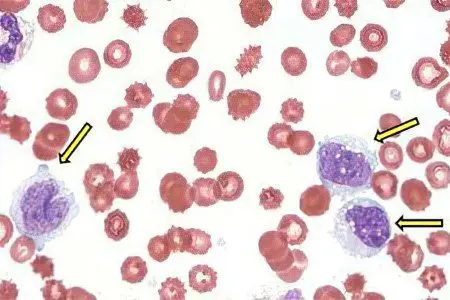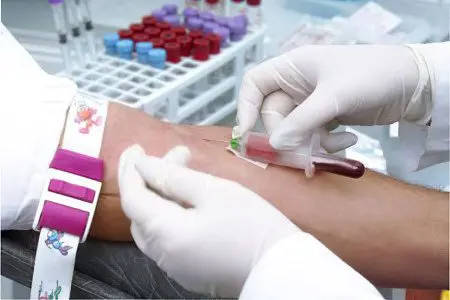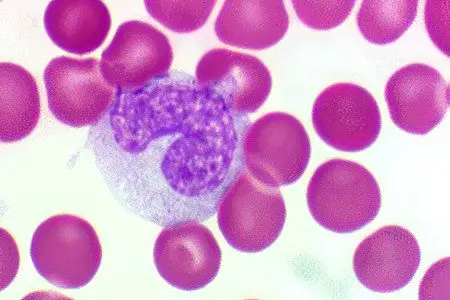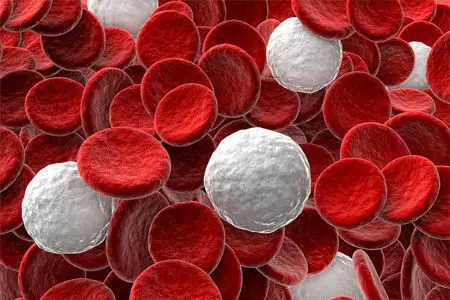Contents

Monocytes are white blood cells, and monocytosis is an increased number of these cells. An increased indicator may indicate the presence of an infection, a disease of the circulatory system, etc.
Basic functions of monocytes

Monocytes are unicellular mature leukocytes that are formed in the bone marrow, their lifespan does not exceed three days. In the bloodstream, they reach the maximum active state. Here they grow, function, and after about 70 hours they degenerate into macrophages, after which they penetrate into the nearest tissues.
Protective and cleansing – it is this function that is their main one. Moving along the blood stream, they find foreign bodies such as: cancer cells, infections, viruses, parasites and try to destroy them. For this, the cell gets close to the detected problem, envelops it with its body, neutralizes it and removes it from the body. Similarly, monocytes destroy bacteria, dead cells and other substances that pollute the human body.
Macrophages operate on the same principle, but they take longer to destroy harmful cells.
Monocytes also take part in the synthesis of interferon, which makes the cells immune to the virus, thereby enhancing the body’s protective functions.
Thus, an increase in the content of monocytes means that there is a disease with which the body is fighting hard by increasing the protective cells.
How is the level of monocytes in the blood determined?
In order to establish the number of monocytes contained in the blood, it is enough to pass a general blood test. Monocytes are a type of leukocyte, calculated by a laboratory assistant using a special leukocyte formula. There are two indicators of monocytes:
Absolute Quantity – referred to as “abs monocytes” or “monocytes mono”, the average number of cells per 1 μl (microliter) is taken into account.
Relative amount – referred to as “value” mln/l, calculated as a percentage
When is it necessary to see a doctor and take a KLA?

There are no specific signs indicating that monocytes are elevated. But at the same time, monocytosis is accompanied by other diseases, the symptoms of which can indirectly suggest changes in the number of leukocytes.
You should consult a doctor with the subsequent delivery of the analysis in case of:
Decreased or complete loss of appetite.
Increased fatigue and causeless weakness.
Aversion to meat dishes.
Sudden weight loss.
Sleeplessness and drowsiness.
Irritation, apathy, nervous breakdowns.
Increased psycho-emotional excitability.
Loud motility of the gastrointestinal tract.
Constant feelings of anxiety.
Unexplained pain in the abdomen.
Panic attacks.
The appearance of foamy stools.
Stool disorders.
The appearance of pain in the joints and muscles.
Bloody impurities in the feces.
The appearance of acne on the mucous membranes.
Skin rashes.
The presence of a long dry cough with bloody sputum.
Eruptions and redness on the genitals, as well as in case of copious discharge from the genital tract.
Discomfort and pain during intercourse.
Deviations and normal values
In the period from birth to the age of 16, the norms of monocytes in the blood change. Absolute values generally go down, in contrast to relative values, which up to 16 years old can either go down or go up.
Human age | Norm of MON parameters |
Newborn | 3-12% |
First two weeks of life | The indicator increases to 5-12% |
By the year | Decreases 4-10% |
By the 2s | Is 3-10% |
From 3 to 16 years old | The lower limit remains 3%, while the upper limit drops to 1%. |
From 16 years old to old age | 3-11% |
Absolute indicators from birth to 16 years should decrease, having initially from 1,9-2,4 million / l, in the end they decrease to 0,004-0,08 million / l
A low level of monocytes in the blood is called monocytopenia, an increased level is called monocytosis.
The focus of inflammation and an increased level of monocytes in decoding will be designated as mono. Absolute monocytosis – an increase in the absolute number of monocytes.
The percentage change in monocytes relative to the total number of leukocytes is called relative monocytosis. Periodically, this indicator can increase as a percentage for various reasons, for example, a very hearty breakfast. That is why minor deviations from the norm have no diagnostic value.
But an increase in white cells in the range of 13-17% can indicate a focus of inflammation, and an indicator of 18-24% indicates a serious infectious and inflammatory process.
Causes of increased monocytes

Absolute monocytosis can develop in an adult in the following cases:
In chronic bowel diseases such as Crohn’s disease, ulcerative colic, inflammation of the small intestine.
Severe chronic diseases: rheumatoid or psoriatic arthritis, lupus erythematosus.
Poisoning by substances which include: phosphorus, chlorine or their compounds.
Infections with infectious diseases: brucellosis, syphilis, salmonellosis, tuberculosis, chickenpox, dysentery, rubella, influenza, whooping cough.
Rheumatological diseases.
Rheumatism, endocarditis.
Blood diseases: chronic myeloid leukemia, osteomyelofibrosis, polycythemia, thrombocytopenic purpura, acute leukemia.
The development of sepsis or the presence of purulent foci.
Penetration into the body of parasites and viruses.
Trauma
Malignant neoplasms of the lymphatic system: lymphomas, lymphogranulomatosis.
Myocardial infarction.
development of fungal diseases.
Also, an excess of the norm of monocytes is observed in patients in the postoperative period and in the recovery period after suffering infectious diseases. Lack of sleep, stress, a hearty meal before the test, excessive physical activity can cause an increase in monocytes. Therefore, it is necessary to take into account these data during the delivery of the UAC.
In men
There are no specific reasons for increasing the level of monocytes in men. Men who often experience stress can suffer from monocytosis, they work a lot, and work is closely related to mental stress and excessive nerves.
Women
Elevated monocytes in a woman’s body indicate the presence of infectious diseases, as well as various inflammatory processes. The norms of leukocyte deviation do not depend on gender, however, in women, unlike men, monocytes can increase due to the characteristics of the reproductive system: during menstruation or ovulation, this is associated with a hormonal surge.
Pregnant women
During pregnancy and lactation, the level of leukocytes is especially important for a woman’s body. This is due to the fact that now the protective function must be performed not only for matter, but also for the fetus inside it, and after the baby is born, they help the woman regain her strength faster. During pregnancy, a restructuring of the immune and endocrine systems occurs in a woman’s body, and the hormonal background often changes, so the ratio of all types of leukocytes changes.
The level of lower monocytes in the first trimester of pregnancy drops to 1%. But after just a few weeks, it again increases to 3%, this indicator remains until the last trimester, in which, due to changes in the hormonal background in connection with the preparation of the body for childbirth, the level of monocytes may increase. Immediately after childbirth, the level drops, but later rises again, which means that the body has begun to recover from childbirth.
Children
The norms of the content of monocytes in the blood in children in comparison with adults are overestimated, the highest is observed in newborns. However, there is nothing to worry about if the age norms are not exceeded or the deviation level is not higher than 10%. An increase in this indicator may indicate the presence of infectious or viral diseases, infection with helminths. Often, the reason for the increase in leukocyte norms can be the change of milk teeth to molars, this is due to the formation of new tissues.
Also, an increase in monocytes may be associated with hereditary factors, with the postoperative period and the presence of more severe diseases, such as leukemia. It is worth noting that in children, a reduced level of leukocytes (monocytopenia) is more often observed than monocytosis, this is more dangerous and may indicate depletion of the body and weak resistance to harmful factors.
Why is it dangerous to increase monocytes?

An increase in monocytes in the body in most cases indicates the presence of pathology. When an infectious disease appears, the body begins a stubborn fight against it by additional production of white bodies to actively fight the disease. It seems that the more monocytes, the better, because this way you can quickly cope with the disease. In fact, there is a downside, since an excessive amount of them can itself provoke inflammation.
Large accumulations of white cells in the vessels can:
Disrupt blood flow.
Strengthen atherosclerosis.
Reduce blood flow to the heart muscle.
Cause damage to the vessel wall.
How to lower the level of monocytes?
Having even a slight increase in monocytes, it is highly not recommended to ignore such a situation. Any changes in monocytes may indicate an inflammatory process. The sooner the patient sees a doctor, the faster and easier it will be possible to get rid of leukocytosis. But the first thing people get lost before is which doctor they should go to, because if monocytes are elevated, the spectrum of diseases is very large.
The first specialist you should contact is a therapist, it is he who will collect an anamnesis, and if necessary, prescribe additional tests, refer you to the right doctor.
In the case of influenza and SARS, the therapist is engaged in treatment, a course of vitamins, antibiotics and other symptomatic drugs is prescribed.
If helminthiasis (ascaris, etc.) is detected, the therapist is also involved in the treatment with the help of a special course of antiparasitic tablets. In cases of severe helminthization (bovine tapeworm, etc.), the help of a gastroenterologist and an infectious disease specialist is required.
Also, the help of an infectious disease specialist will be required when identifying: chickenpox, dysentery, measles, etc. The patient is hospitalized and the necessary treatment is prescribed.
When during the examination the therapist revealed diseases of the gastrointestinal tract in an exacerbated form (ulcer, gastritis, enteritis, etc.), then the gastroenterologist is engaged in the treatment. The main task is remission, for this the patient is prescribed aminosalicylates, immunomodulators, corticosteroids. At the end of the course, the patient submits a control analysis. The level of leukocytes is within the normal range and will mean the onset of remission.
With such a disease as syphilis, treatment takes place in a dermatological dispensary, general strengthening drugs and a course of antibiotics are prescribed.
The development of malignant tumors are the most serious diseases that an oncologist deals with. An examination is carried out, the doctor determines the stage of the disease, the degree of spread, the localization of the tumor, depending on these indicators, a course of radiation therapy, chemotherapy or surgery is prescribed. For each patient, the treatment plan is built individually, but the goal is the same – to prevent the spread of the tumor.
In cases where an increase in monocytes was a consequence of stress, then a psychologist can help, in more difficult situations, a psychotherapist. For treatment, means are used that control the psycho-emotional state along with psychotherapeutic sessions.









